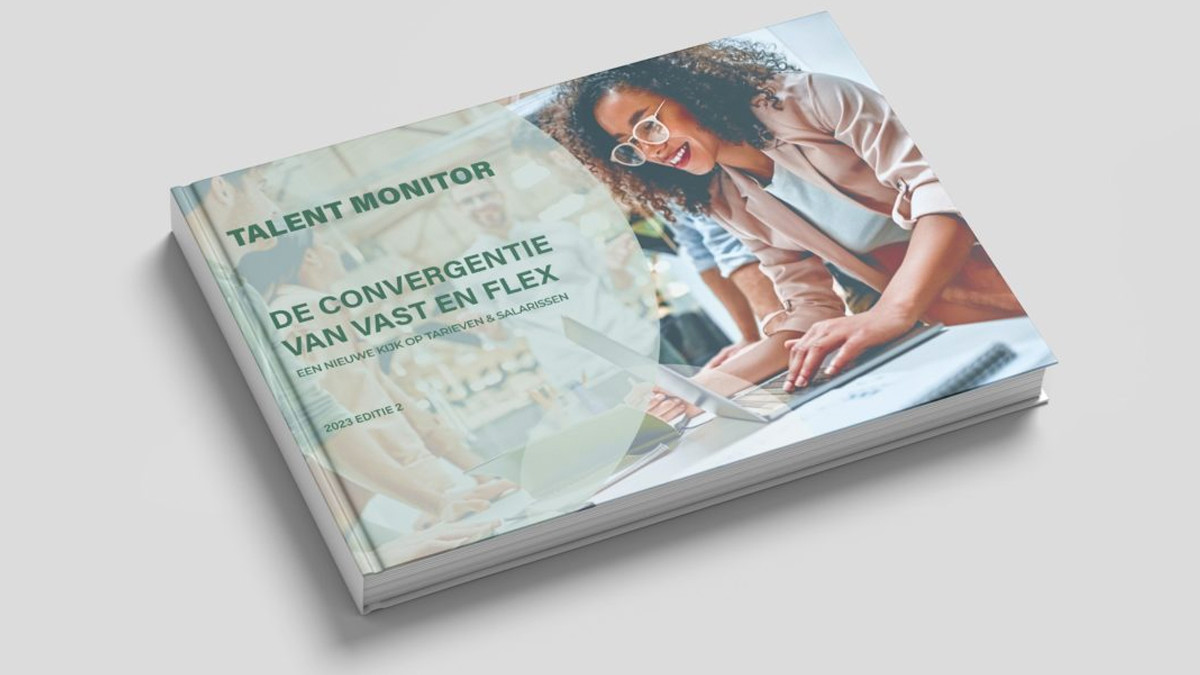Talent Monitor | The future of rates for independent professionals: what you need to know for 2025
As an independent professional or self-employed person, you are in the business of delivering value to your clients on a daily basis. But what about the value you yourself receive for your work? Rates for independent professionals are constantly changing. What can we expect in 2025?
This Talent Monitor offers answers to this question and provides a comprehensive analysis of the latest trends. Here are some of the key insights you won't want to miss:
1. Rising rates, but lagging behind inflation
Fees for independent professionals continue to rise, but not always in line with inflation. In 2024 we saw a moderate increase of 3.6%, but the increase in 2025 is expected to be between 0.5% and 1%. What does this mean for you as a self-employed person? Is it time to reevaluate your rate?
2. Scarcity remains, and zzp'ers remain in the driver's seat
Independent professionals have the luxury of choosing from a variety of assignments. On average, self-employed professionals are approached 16 times a year for new assignments. Despite a slight decrease in approaches, the labor market remains tight, and this affects the supply and demand of professionals. Zzp'ers are still in control and can determine the conditions under which they work.
3. An increase in numbers, but self-employed people continue to make choices
The number of self-employed workers continues to rise, approaching 1.1 million. Yet we see that only 12% of self-employed professionals are considering returning to salaried employment, while interest in becoming self-employed from salaried employment is significantly higher. This shows that the flexibility and freedom of self-employment remains the preferred option for many professionals.
4. What do you expect for 2025?
According to the Talent Monitor, there are strong indications that rates for self-employed workers will increase slightly in 2025, despite a possible deterioration in the labor market. This increase will depend on several factors, such as vacancy rates and economic conditions, but rates are expected to grow between 0.5% and 1%.
Download the full report
Want to know more about the expectations for 2025? Then download the Talent Monitor now from our parent organization HeadFirst Group's website and get a detailed overview of everything you need to know to stay one step ahead!
Download the report here.
With these insights, you can not only improve your strategy as an independent professional, but also be prepared for the changes that 2025 will bring. Make sure you align your rates and work strategy with the market conditions of the coming year!

Hiring desk: for all practical self-employment issues
Uncertainties and expectations surrounding labor market and self-employment legislation after summer in The Hague
The choice of self-employment over a traditional salaried job is on the rise. However, besides many advantages, such as freedom and flexibility, there are also less attractive sides of entrepreneurship, such as administration and acquisition. In an interview with the AD, Sjanne Marie van den Groenendaal, researcher at Tilburg University and self-employed expert, advises to outsource tasks in which you are not strong or to enlist help. At Inhuurdesk, we can help you with this!

As a self-employed person, you have enough on your plate: often fun assignments, but also tasks you'd rather put off. Tasks such as collecting invoices, arranging insurance and other administrative matters often remain on your to-do list. Something you really have to take care of eventually. With our Professionals services we take these worries out of your hands and offer the following solutions:
- Prompt payment of invoices through ENTRPNR
No more dependence on payment terms and your client's payment behavior. With Advanced, your invoices are paid 14 days after receipt. And the convenient thing is that you can always check the status of your invoice online. Do you want to be paid even faster? Then choose Complete, where payment is made within 10 days.
- Comprehensive insurance through Alicia
Carefree self-employment means having your risks properly covered. With Advanced you are comprehensively insured for business and professional liability, cyber risks and accidents. With Complete, you can even take advantage of disability coverage.
- Get smarter every day with our learning & development tools
This includes unlimited online learning subscriptions to the Select Academy, discounts on training and advice from a job coach (Excellent).
- Personal contact and advice
A dedicated relationship manager is on hand to answer all your questions and offer advice on things like your resume, what rate is best to offer for an assignment and other tips for presenting yourself successfully.
Why our services?
We offer an all-in-one solution for all the practical matters you want taken care of as a self-employed person. Our services include carefully selected products offered by leading partners. Payment is per hour worked, so there are only costs if you generate income. For more information on all the benefits of the Professionals services, visit the Inhuurdesk website.
The cabinet has fallen, now what?
Uncertainties and expectations surrounding labor market and self-employment legislation after summer in The Hague
In the aftermath of the fall of the Cabinet, political parties will, for now, be mostly preoccupied with questions such as, "Who will be our new party leader?", "Which candidates will be placed on the electoral list?" and "How can we put together an expert and strong committee to write a new party program?" Nevertheless, there is still a missionary House of Representatives that will decide whether a caretaker government can continue to develop certain bills and plans.

Minister Van Gennip (SZW) was well on her way and planning to present some legislative proposals after the summer. One of these proposals was aimed at creating a clearer separation between employees and the self-employed through the criterion of embedding and entrepreneurial criteria as a contraindication to an employment contract. It is possible that the House of Representatives will declare this bill controversial.
If that is the case, the introduction of new legislation will be delayed and there will continue to be (legal) uncertainty for a longer period of time as to when someone is considered an employee and when a self-employed person. We will have to wait and see how relations in the new Lower House develop and what plans a future cabinet will come up with regarding the labor market and the self-employed dossier. An implementation date of January 1, 2025 therefore does not seem realistic.
Disability Insurance
Another important issue is the introduction of compulsory disability insurance (AOV) for the self-employed. This has recently received a lot of attention in the media and has also been hotly debated in the House of Representatives. There is also a chance for this dossier to be labeled controversial. At the same time, the outgoing cabinet finds itself in a difficult position, since the plans were agreed upon in consultation between employers and employees, and the Netherlands has pledged to the European Union to offer the self-employed more protection against the consequences of disability through such insurance.
Enforcement of labor relations
There is also a lot to do on the subject of enforcement of labor relations by the Tax Administration. The coalition agreement stipulates that the enforcement moratorium will end on January 1, 2025. Shortly before the fall of the Cabinet, a motion was passed by the PvdA and GroenLinks to introduce sectoral enforcement, starting in social sectors such as healthcare, education and childcare. This does not require a new law, but it is desirable, including for the Tax Administration itself, to legally make a clearer distinction between employees and the self-employed. In the fall, the Tax Administration will present a new enforcement plan, which will also provide more clarity on the timeline toward January 1, 2025.
These are uncertain and turbulent times in the political arena in The Hague. After the summer recess, we hope to have more clarity on all the plans and bills related to the labor market and the self-employed dossier.
Budget Day 2023: What can we expect?
Important Tax Changes and Legislative Developments for Entrepreneurs
The third Tuesday of September marks Budget Day, and this year it was a special edition. The outgoing Rutte IV administration has limited room for large-scale plans and financial generosity due to the fact. Moreover, government finances are under increasing pressure, and political parties are already gearing up for the Lower House elections in November. This translated into what politicians like to call a "policy-poor" budget, with few major decisions. Below is an overview of some of the most relevant plans and measures.
- SME profit exemption further reduced
The SME profit exemption will drop from 14% to 12.7% from Jan. 1, 2024. This exemption is a scheme that reduces taxable profits after entrepreneurial deductions. This affects entrepreneurs who use this scheme, as they will have a larger portion of their profits or income taxed. In particular, entrepreneurs with higher profits will be hit the hardest financially.
- Continued reduction in self-employment deduction
Since 2020, the self-employed deduction has been gradually reduced, and in 2024 it will drop by €1280 to €3750. Until 2027, this reduction will continue to an amount of €900. This is in line with the broader policy to create a level playing field between employees and the self-employed.
- Increase in untaxed travel reimbursement
In 2024, the untaxed mileage allowance will be increased from €0.21 to €0.23. As an entrepreneur, you may deduct this amount from the profit for business trips with a private car, motorcycle or bicycle. As an employer, you may also give untaxed compensation to your staff. This applies to commuting and other business travel by private vehicle.
- Austerity of Energy Investment Deduction
Are you investing in energy-saving measures and sustainable business assets? Then you are eligible for the Energy Investment Allowance (EIA), whereby a percentage of the investment costs may be deducted from profits. The EIA for entrepreneurs will be extended until 2028, but the percentage that can be deducted in the process will drop from 45.5% to 40% in 2024. The investment is minimum €2500 and maximum €136 million. So it may pay to make large investments in 2023 to take advantage of the higher percentage.
- Changes to Box 1 income
The tax rate for income in Box 1 will be changed. In 2024, people within that box will pay 36.97% tax on income up to €75,624, a slight increase from 2023. For income above €75,624, the rate remains at 49.5%. The amount of these writing limits increases less than inflation this year, so you'll reach the higher rate of the second bracket sooner.
- Changes to Box 2 income
In 2024, profits from shares in a company will be taxed in a two-tier system if you own 5% or more of the shares in a company. Up to €67,000 income pays 24.5% tax, above that 31%. For profit distributions up to about €106,000, the tax in Box 2 in 2024 is lower than in 2023, but at higher profit distributions one pays more tax. It may be interesting to distribute accumulated profits in your business as late as 2023.
- Income-related health insurance law contribution
Employers in 2024 will pay an employer health insurance law levy of 6.57% on up to €71,624, down slightly from 2023. Self-employed persons will pay an income-related healthcare insurance law contribution of 5.32% on the maximum contribution wage of €71,624, also a slight decrease. You will receive the (preliminary) assessment for the income-related healthcare insurance law contribution at the same time as the (preliminary) tax assessment.
- Further development of legislation and enforcement
The Ministry of Social Affairs and Employment is continuing to work on the bill to make a clearer distinction between self-employed workers and employees, with criteria such as "authority," "embedding," and "self-employment. The Tax Administration is working on improvements in enforcement to combat false self-employment. Work is continuing on the legal presumption of employment below an hourly rate of €32.24. At a lower hourly rate, there is a legal presumption of employment. It is then up to the employer to prove that this is not the case.
In short, Budget Day 2023 brought some important changes for business owners and taxpayers. It is advisable to consider these changes and discuss them with an advisor if necessary.
Talent Monitor: Rate development professionals 2023
Evolution of Total Talent Management: The Tenth Edition of the Talent Monitor
In collaboration with Intelligence Group, an ambitious step was taken in late 2021 by forecasting rate trends for professionals in 2022. This included both independent professionals and those employed by secondment companies, in as many as 114 different professional groups. Halfway through that year, we also released an interim update on the predicted trends.

However, this forecasting model appears to be broken. Indeed, the crucial factors of "inflation" and "scarcity development" have exceeded the limits of the model. Inflation has risen so significantly that it is almost equal to the total inflation of the past decade. This scarcity also affects economic models, such as the business cycle clock, and seems to defy any logic.
What we initially considered to be an annual tradition is now proving, given the correctness of our predictions and the growing amount of available data, to be too wide a gap between theory and practice. Therefore, there is no shame in admitting that our forecasting model is currently not working properly. As a result, we are unable to offer a rate forecast for 2023 comparable to last year.
In this edition of the Talent Monitor, we take a look back at rate trends in 2022 and share our expectations for 2023, including:
- By 2022, professionals' hourly rates rose an average of 3.8%.
- Hourly rates of professionals in 2023 are expected to increase on average by 4% to 6%. This is influenced by several factors, such as keeping pace with developments in collective bargaining rates.
- Nor do clients take drastic measures to index rates of professionals on current assignments; they prefer a performance-based approach. Higher rates are mostly paid on new assignments.
In short, although the forecasting model has been disrupted, we still share valuable insights and expectations for future rate trends in the labor market. Curious about all the results? Download this edition of the Talent Monitor here.
About the Talent Monitor
Intelligence Group and HeadFirst Group, of which Inhuurdesk is a part, present unique quarterly insights based on recruitment and labor market data from Intelligence Group, combined with hiring data from HeadFirst Group. Both data sources are stored in a structured way, in accordance with the ISCO standard.
Talent Monitor: The convergence of fixed and flex
Evolution of Total Talent Management: The Tenth Edition of the Talent Monitor
Step by step, permanent and flexible labor data are moving toward each other. This process is not without challenges, because in many cases they can be compared like oranges and tangerines: they have similarities, taste somewhat the same, yet are distinctly different. Compare it to a minneola, a cross between the two fruits. When we look at data, talent intelligence and dashboards for both permanent and flex, we see a convergence taking place.

It goes beyond simply integrating two different data points into one dashboard. Meanwhile, they are unified in the same view and therefore have become comparable. Although there are still nuances to this comparison and they are not completely interchangeable, it still represents significant progress. We are moving from the theoretical concepts of Total Talent Management to a practical model.
We now present the tenth edition of the Talent Monitor. So far, this has been a long journey through the worlds of both permanent and flexible employment in the labor market, uncovering secrets. Some findings were obvious, such as the fact that the flexible labor market tends to be less tight than the market for permanent jobs, and that the duration of assignments tends to be shorter than the duration of regular employment contracts - although this difference is getting smaller. However, surprising insights have also been demonstrated, such as:
- The relationship between the development of rates, inflation and the time period of matchmaking; rates increase at the beginning of the year, but barely at the halfway point or at renewal.
- Competition between independent professionals and staffing agencies.
- The correlation between scarcity and labor market activity.
- Self-employed professionals place less value on the flexibility of clients because they are already fundamentally flexible and therefore take charge themselves.
In this Talent Monitor, we once again unravel data and continue to surprise with new insights. We take a unique step by comparing rates for permanent and flexible staff, across different target groups. For example, which hired professionals are significantly more expensive than their permanent colleagues, and which are not? This is an important development towards a full-fledged data model for Total Talent Management.
Curious about all the results? Download this edition of the Talent Monitor here.
About the Talent Monitor
Intelligence Group and HeadFirst Group, of which Inhuurdesk is a part, present unique quarterly insights based on recruitment and labor market data from Intelligence Group, combined with hiring data from HeadFirst Group. Both data sources are stored in a structured way, in accordance with the ISCO standard.
Getting a grip on the zzp dossier: Facts and insights on self-employed workers in 2023
The landscape of zzp'ers in the Netherlands
There are as many as 1.2 million people in the Netherlands who are self-employed without personnel (zzp'ers). This means that one in eight persons in paid employment earns his or her living as a self-employed person. The position of this sizeable group is causing considerable discussion within the political debate. Back in 2021, it emerged that these discussions were often held on the basis of incorrect data and misinterpretations. These figures were now due for another update.

Knowledge platform ZiPconomy has therefore, at the request of HeadFirst Group and ONL voor Ondernemers, compiled another report in 2023 with the most up-to-date figures and developments regarding the self-employed population in the Netherlands. The aim of this revised edition is unchanged: to chart the diverse group of self-employed people and to elevate the self-employed dossier, and thus the labor market debate, to a higher level. Thanks to the insights from this report, misconceptions about the self-employed are a thing of the past.
Some new insights from this report include the following:
- The vast majority of the self-employed provide services (own labor). The number of self-employed people selling products decreased. Over a tenth of the employed labor force is self-employed own labor. In 2013, the figure was 8.2%.
- More than half of the self-employed are men. The proportion of women is rising, but this is still nowhere near as evenly distributed as among employees. Almost half of the self-employed are between the ages of 35-55.
- Almost half of the self-employed have a college education or higher. Remarkably, female self-employed workers are more often higher educated than men.
- The largest category of self-employed workers is the group providing "specialized business services. Followed by health and welfare, construction and IT. Most of the self-employed who supply their own labor to organizations have four or more clients.
- The vast majority of self-employed workers (83%) are (very) satisfied with their work situation. Among employees, this percentage is 78%. Direction over the working day is most often mentioned as a motive for becoming self-employed in 2023.
The findings in this report are largely based on results from 2013 to 2023 from TNO's Self-Employment Survey (ZEA) and Statistics Netherlands (CBS). The emphasis here is on self-employment. Curious about all the details and insights? Download the report on the website of our parent organization HeadFirst Group.







